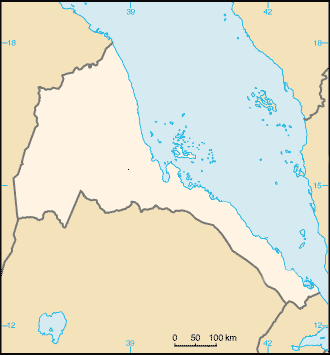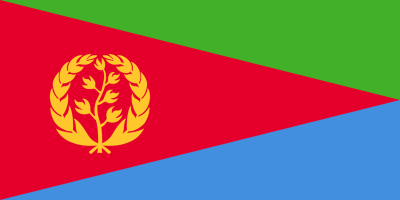Eritrea Military Power Ranking 2025
MPR Rank: 77th
MPR SCORE: 388
MPR Index: 0.1392 (1.0000 is perfect)
Reverse MPR Index: 0.8158 (0.0000 is perfect)
Z Score: -0.162 (standard deviations above the mean)
Overview
Eritrea ranks 77th in the 2025 Military Power Rankings (MPR). As one of Africa’s most militarized states, Eritrea maintains a disproportionately large military for its size, heavily shaped by its war of independence from Ethiopia and the 1998–2000 border conflict. The Eritrean Defense Forces (EDF) operate under the centralized control of President Isaias Afwerki, with a doctrine rooted in national mobilization, border defense, and regime preservation. While Eritrea possesses a sizable infantry force and hardened combat veterans, it suffers from international isolation, economic stagnation, and a nearly total absence of modernization. Mandatory indefinite conscription, international sanctions, and reliance on outdated Soviet-era hardware constrain its operational readiness and strategic potential.
Strengths
1. Large and Entrenched Infantry Force
The EDF maintains one of the largest active military-to-population ratios in the world, with a deeply entrenched conscription system and reserves formed from universal national service, creating a force capable of rapid mobilization.
2. High Battlefield Toughness and Morale
Combat units are hardened by past wars and guerrilla experience, with a reputation for tenacity in defense, especially in rugged terrain along the Ethiopian and Sudanese borders.
3. Complete Command Centralization
The military is under total state control, with no factionalism, mutiny, or civilian oversight. This provides internal stability and predictability in terms of unit discipline and chain of command.
4. Strategic Depth Through Terrain
Eritrea’s mountainous geography and control of key highlands provide a natural defensive advantage against incursions, especially from the Ethiopian border and Red Sea approaches.
Why Eritrea Is Ranked 77th
1. Indefinite Conscription and Poor Training Cycles
Universal national service is indefinite, leading to low morale, exhaustion, and a lack of fresh training cycles
No clear NCO development pipeline or formal career progression structure
2. Obsolete Equipment and Lack of Air/Navy Capability
Army relies on Soviet-era tanks, artillery, and small arms with minimal upgrades
Air Force mostly inoperable; aging MiG-21s, MiG-29s, and helicopters with poor maintenance
Navy is negligible; operates small coastal craft with no maritime deterrence role
3. International Isolation and Strategic Inflexibility
Eritrea is under sanctions, with limited defense trade, foreign training, or international cooperation
No regional alliance participation; seen as a pariah state in African and Arab security circles
Military doctrine is static and defense-centric, lacking any force projection or cyber capability
Conclusion
Eritrea’s military is best understood as a regime maintenance tool, rather than a regional power instrument. While the Eritrean Defence Forces remain large, cohesive, and battle-tested, they lack the modernization, flexibility, and force projection that define higher-ranked militaries. Eritrea’s international isolation, obsolete platforms, and indefinite conscription system prevent it from transitioning into a 21st-century defense force. As such, Eritrea ranks 77th—a country with entrenched defensive strength but limited military value beyond its borders.
Military Strength and Force Projection
Active Military Personnel: 200,000 (IISS 2023)
Reserve Personnel: 120,000 (Estimate based on conscription model)
Paramilitary Forces: 10,000 (People’s Militia and Internal Security) (CIA World Factbook 2023)
Army Personnel: 180,000 (Jane’s Defence 2023)
Navy Personnel: 2,000 (IISS 2023)
Air Force Personnel: 8,000 (SIPRI 2023)
Ground Forces
Main Battle Tanks (MBTs): 250+ (T-55, T-72, M46 Patton) (IISS 2023)
Armored Fighting Vehicles (AFVs): 500+ (BMP-1, BTR-60, EE-9 Cascavel) (Jane’s Defence 2023)
Artillery (Towed and Self-Propelled): 400+ (BM-21 Grad, D-30 Howitzers) (SIPRI 2023)
Air Force
Combat Aircraft: 20+ (WDMMA 2021)
Helicopters: 30+ (WDMMA 2021)
Transport Aircraft: 10+ (IISS 2023)
Aircraft Breakdown:
Su-27: 8 (Jane’s Defence 2023)
MiG-29: 10 (SIPRI 2023)
L-39 Albatros: 5 (Trainer & Light Attack) (IISS 2023)
Mi-24 Hind: 12+ (Attack Helicopter) (WDMMA 2021)
Naval Forces
Submarines: 0
Frigates: 0
Corvettes: 0
Patrol Vessels: 8 (Chinese and Iranian-made patrol boats) (Jane’s Defence 2023)
Fast Attack Craft: 4 (IISS 2023)
Landing Craft & Auxiliary Ships: 3 (SIPRI 2023)
Missile Capabilities
Eritrea does not possess ballistic missiles but operates various air defense and anti-tank missile systems, including:
S-125 Pechora Surface-to-Air Missiles (SAMs) (Jane’s Defence 2023)
Igla MANPADS (Portable Air Defense Missiles) (IISS 2023)
AT-5 Spandrel Anti-Tank Missiles (SIPRI 2023)
Strategic Partnerships
Eritrea has strong defense ties with Russia, China, and Iran, acquiring military equipment and technology from these countries. It also has military cooperation agreements with North Korea and the UAE, particularly in the area of asymmetric warfare and naval development.
Due to its isolation from Western military alliances, Eritrea relies heavily on self-sufficiency in training, local weapons manufacturing, and militia-based defense strategies.
Military History & Combat Experience
Eritrea's military identity is deeply rooted in its liberation struggle, border wars, and defensive military doctrine shaped by decades of conflict with Ethiopia and near-total self-reliance.
Eritrean War of Independence (1961–1991):
Eritrea’s defining military legacy stems from a 30-year guerrilla campaign against Ethiopian occupation, led by the Eritrean People's Liberation Front (EPLF). The EPLF developed deep logistics-in-depth, asymmetric warfare tactics, and a highly disciplined fighting force, which laid the foundation for the modern EDF.Eritrean–Ethiopian Border War (1998–2000):
A brutal conventional war fought over the Badme region, resulting in tens of thousands of casualties. Eritrea fielded large infantry units and sustained trench warfare along fixed fronts. Though the war ended in stalemate, it hardened Eritrean doctrine around perimeter defense and mass mobilization.Yemeni Island Dispute (1995):
Eritrean forces briefly occupied the Hanish Islands in a confrontation with Yemen, deploying troops and patrol boats. Though resolved via international arbitration, the incident showcased Eritrea’s willingness to assert territorial claims in the Red Sea.Involvement in Tigray Conflict (2020–2022):
Eritrea deployed troops into northern Ethiopia during the Tigray War, reportedly fighting alongside Ethiopian federal forces. EDF units were accused of involvement in atrocities and counter-insurgency operations, though exact deployments remain classified.
Eritrea’s military remains highly capable of territorial defense, but its strategic posture and force structure have not evolved beyond Cold War-era conventional doctrine, despite modern threats.
General Information
Demographics and Geography
Population: ~3.7 million (2024 est.)
Population Available for Military Service: ~1.3 million
Geographic Area: 117,600 km²
Land Boundaries: 1,840 km
Bordering Countries: Djibouti, Ethiopia, Sudan
Coastline: 2,234 km
Climate: Hot and arid in coastal plains; cooler and wetter in the highlands
Terrain: Coastal desert plain, central highlands, western plains
Natural Resources: Gold, copper, zinc, potash, fish, marble, salt, arable land
Proven Oil Reserves: None proven; exploration ongoing
Proven Natural Gas Reserves: None proven
Economic Indicators
Defense Budget (2025): ~$650 million USD (estimated)
Defense Budget as % of GDP: ~5.5%
GDP (PPP): ~$11.8 billion USD
GDP per Capita (PPP): ~$3,200
External Debt: ~$3.7 billion USD
Military Expenditure Trend (last 5 years): High; ongoing conscription and frontier posture
Military Infrastructure and Readiness
Military Service Obligation: Mandatory for all adults (indefinite national service)
Primary Defense Focus: Border defense, asymmetric deterrence against Ethiopia
Military Industry Base: Basic; local repair, ammunition, and legacy stockpiles
Cyber/Electronic Warfare Capability: Minimal
Nuclear Warhead Inventory: None (non-nuclear state)
Major Military Districts / Commands: Divided into four regional operational commands
Missile Inventory Highlights: BM-21, MANPADS, short-range artillery
Reservist Call-up Readiness / Timeline: Entire population under indefinite conscription
Reservist Force Size: ~200,000
Space, Intelligence, and Strategic Infrastructure
Space or Satellite Programs: None
Military Satellite Inventory: None
Intelligence Infrastructure: Office of National Security, Military Intelligence
Intelligence Sharing Partnerships: Limited; regional cooperation with Russia and Iran
Airports (Total): ~21
Major Military Airports: Asmara, Massawa, Assab
Naval Power and Maritime Logistics
Merchant Marine Fleet: Minimal
Major Ports: Massawa, Assab
Naval Infrastructure: Coastal patrol fleet; small amphibious and logistics vessels
Naval Replenishment Capability: Minimal
Domestic Mobility and Infrastructure
Railway Network: ~300 km (partially operational)
Roadways: ~14,000 km
Energy and Fuel Logistics
Oil Production: None
Energy Imports: High; reliant on diesel imports and limited solar/hydropower
Strategic Petroleum Reserves: Minimal
Defense Production and Strategic Forces
Domestic Defense Production: Limited to repair and basic ammunition
Military Installations (Domestic): High concentration near Ethiopian border
Military Installations (Overseas): None
Foreign Military Personnel Presence: Past UAE base (Assab); now vacated
Defense Alliances: Informal cooperation with Iran, Russia
Strategic Airlift Capability: Soviet-era aircraft; minimal functional lift
Wartime Industrial Surge Capacity: Extremely limited
Research and Industry Support
Defense R&D Investment: Negligible
Key Wartime Industries Beyond Defense: Mining (Nevsun legacy), construction corps, state agriculture
Political and Administrative Structure
Capital: Asmara
Founding Date: May 24, 1993 (independence from Ethiopia)
System of Government: Unitary one-party presidential state



